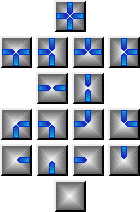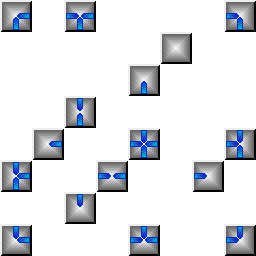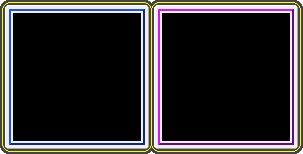| You're looking at the front and back of a 15-puzzle. Either side is solved if each line radiating from the center of a tile finds a match. There are 652 solutions in two classes, 326 in each.
The four trivial solutions are also meta solutions, that is: both sides of the puzzle are solved simultaneously. Other trivial solutions exist on either front or back, but not as meta solutions. | ||||||||||
| There are exactly four more meta solutions! They are distinctively non-trivial. Find one, and all will appear in the pop-up menu. To make things easy, you'll find all 652 solutions in this 'slide show'. Rotations and reflections are not equivalent in BackSlide. Number 30 for instance is a rotation of A1, but it will not give a meta solution in BackSlide. |
History
| Obviously the history of BackSlide goes back to the invention of the '15-puzzle', commonly attributed to Sam Loyd. The set of 15 tiles used in BackSlide is a subset of the 16-tile set depicted here. Attentive readers will recognize it as the 'square' version of the China Labyrinth. It is much simpler and less flexible, but it allows for the same types of solutions: transcendental, compact and starmap. Compact solutions are the ones provided in the slideshow. They allow both line-to-line and blank-to-blank contacts. Tijs Krammer was the first to put the set in a 15-puzzle. Christian Freeling conceived the idea of a second one on the back, and the idea of 'meta-solutions'. Ed van Zon wrote the program and the current mapping of front and back turned out to be the only one allowing such meta-solutions, other than the trival ones, (except of course the mapping with only meta-solutions). |  |
| Transcendental solutions Transcendental solutions are different in that they don't allow contact between blank sides. If the lines are removed from it, no information is lost. Here's a 'transcendental solutions generator' to illustrate the point. In both types of solution, the number of independent groups will always equal the number of 'loops' in the figure (the blank counts as one group). |
Starmaps
| A starmap is another type of trancendental solution. In it, looking along a line from any tile, one encounters - at some distance - a tile with a matching line. Looking in a 'blank' direction one encounters only nothingness. The minimum size of a starmap is 8x8. In this example, the blank is inside the constellation, and no two tiles are adjacent. This is considered good form. |  |
BackSlide © MindSports
Java applets by Ed van Zon

































